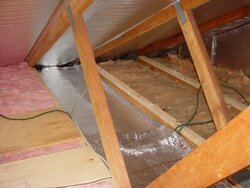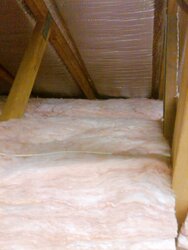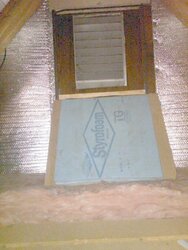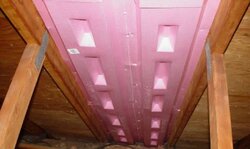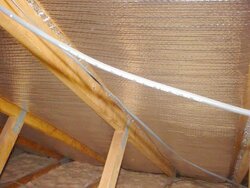Uncle said:
I took the advice that I got here n hearth.com to insulate before I get my insert. I am done insulating the walls in which we used roxul r-15 with 6 mill plastic for a vapor barrier and plenty of tyvec tape.
Now I am ready to do the attic and I'm looking for suggestions, advice and cost estimates.
Note: The house is in central New Jersey. I'm guessing I have about 800 square feet. We would like to still use a portion for storage space if possible. We plan to live here for the long haul. Also the ventalation is mushroom caps and a temp controled attic fan, there are no sofits.
Here is my story.
I have a split Entry home built in 1962
A. Save heat in winter by insulating Attic Floor better and closing up gable vents
Pic 1. Rip 2x4s down to create 2x2s and nail them to the 2x4s.
Remove OLD R7 Stamped ECONOMY Owen Cornings Fiberglass Paper Faced Insulations
Pic 1. Air seal all holes with Can Foam
Roll down Reflectix Foil R3.9 then roll down R19 Fiberglass Paper Faced Insulation on top of Foil
Pic 2. Criss Cross with Unfaced R30 Fiberglass insulation for a tolal of R53 in floor!
Pic 3. Since I now have a Ridge Vent and Soffit Strip vent I built doors to close gable vents in Winter
Also insulate and foil Gable Vent End Walls for better insulation. amazing now by doing tha the paint never peels in the outside triangle where gable vent is because there is no extreeme temp diff between inside and outside!!
Saves a tremendous amount of heat being sucked out of the house from cold winter winds blowing in!!
B. Save Air Conditioning cost in summer by reflecting heat and keeping cool in!
Pic 4. Staple Rafter vents from soffit all the way up to ridge vent to maintain cool roof!
Pic 5. Staple Reflectix foil over rafter vents to keep whole house 10 Degrees cooler in summer
Only need air conditioning if too humind now, never gets too hot!!
Open Gable vent doors for additional cooling!!
End result Big $avings in summer and winter!!


